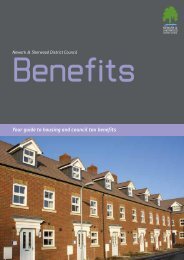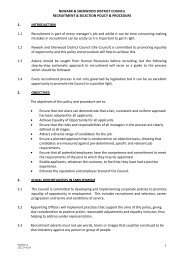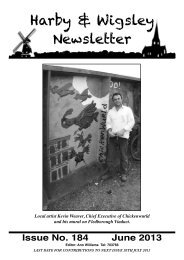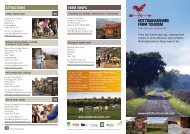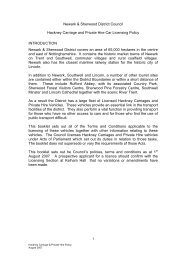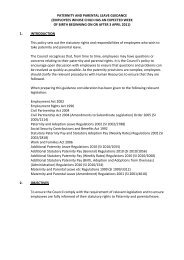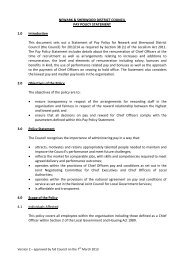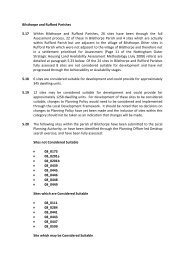Southwell CA Appraisal.pdf - Newark and Sherwood District Council
Southwell CA Appraisal.pdf - Newark and Sherwood District Council
Southwell CA Appraisal.pdf - Newark and Sherwood District Council
You also want an ePaper? Increase the reach of your titles
YUMPU automatically turns print PDFs into web optimized ePapers that Google loves.
It is likely that the Minster is on the site of this early church but the existing building is thought to<br />
have been started between 1109-14. At this time the status of the Minster was raised to Mother<br />
Church of all Nottinghamshire. On the formation of the <strong>Southwell</strong> Diocese in 1884, the Minster<br />
became a Cathedral.<br />
The Church had a unique system of administration in the form of a collegiate body of secular<br />
canons that administered the affairs of the Minster Chapter. The canons were supported by income<br />
from endowments of property <strong>and</strong> tithes known as prebends. As a result the canons were known as<br />
prebendaries. Each prebendary had a house in <strong>Southwell</strong> named after the village from which their<br />
revenues were derived (except Halloghton Prebendary which had its prebendal house at Manor<br />
Farm in Halloughton). These houses were set in large plots in Church Street <strong>and</strong> Westgate <strong>and</strong><br />
many of their large gardens are still evident. The collegiate body lasted until 1840 when an Act<br />
suspended future appointments to prebends <strong>and</strong> was extinguished altogether with the death of the<br />
last prebendary in1873. This collegiate foundation was larger <strong>and</strong> lasted longer than any other in<br />
the country.<br />
Very little is known about medieval Easthorpe <strong>and</strong> Westhorpe. The names of Easthorpe <strong>and</strong><br />
Westhorpe date from the occupation by the Danes in the C9 <strong>and</strong> C10, “torp” being the<br />
Sc<strong>and</strong>inavian for an outlying hamlet near a large settlement. They were agricultural in character.<br />
Easthorpe being closer merged with the town of <strong>Southwell</strong> first. Westhorpe only merged when the<br />
straggle of C18 <strong>and</strong> C19 development along Westgate was consolidated in the C20.<br />
Records from the C16-C18 show the continued development of <strong>Southwell</strong> around the Burgage,<br />
King Street, Queen Street, Westgate <strong>and</strong> Church Street. The <strong>Southwell</strong> tithe map of 1841 (see map<br />
2) shows this historic layout <strong>and</strong> it is this core that is the basis of the conservation area.<br />
While not predominantly an industrial town <strong>Southwell</strong> does have an industrial heritage. <strong>Southwell</strong><br />
was an important area for hop growing in the 1700s <strong>and</strong> 1800s – mainly along the banks of the<br />
River Greet. There were many malthouses in <strong>Southwell</strong> <strong>and</strong> the Maltings <strong>and</strong> Brewmaster’s House<br />
on <strong>Newark</strong> Road, erected 1825, are testimony to this industry, although at one time most of<br />
<strong>Southwell</strong>’s inns had their own brewing facilities. Greet Lily Flour Mill, built 1851 but remodelled<br />
following two disastrous fires, still survives <strong>and</strong> close to <strong>Southwell</strong> is Maythorne, an industrial<br />
hamlet built by the River Greet. The complex comprises a series of mills <strong>and</strong> cottages, probably<br />
first used for cotton spinning but certainly later for silk. Lace also featured in <strong>Southwell</strong> <strong>and</strong> the<br />
once the House of Correction ceased to be used in 1880 the building was used as a lace factory.<br />
The making of lace was also carried out on a domestic scale in framework knitters’ workshops, as<br />
seen in many other Nottinghamshire towns <strong>and</strong> villages.<br />
The levels of post C18 development were low in <strong>Southwell</strong> <strong>and</strong> this helps to account for the small<br />
size of the town. It was not until the mid C20 that major growth took place again with several<br />
residential areas developing around the historic core.<br />
There are still many unanswered questions <strong>and</strong> gaps in our knowledge about the development of<br />
<strong>Southwell</strong> <strong>and</strong> it is likely that archaeological investigation will be required whenever new<br />
development is proposed.<br />
L<strong>and</strong>scape Setting<br />
The l<strong>and</strong>scape setting of <strong>Southwell</strong> makes an important contribution to its character. It is set<br />
within an undulating l<strong>and</strong>form that is well wooded - large swathes are identified as Mature<br />
3



